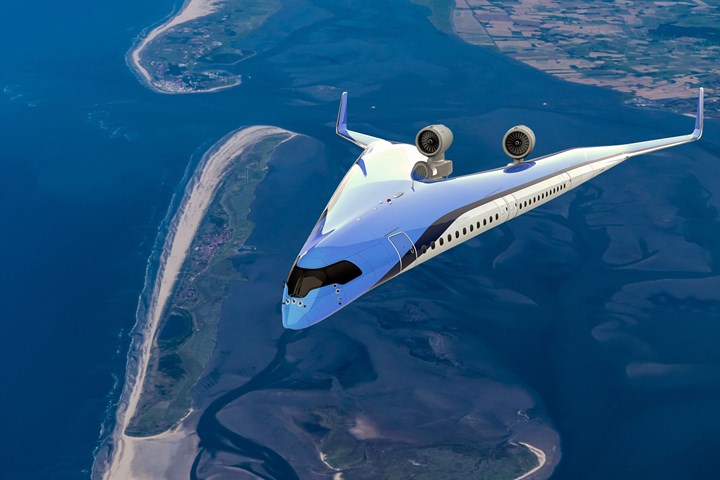TU Delft, KLM's Flying-V aircraft performs successful maiden flight
With the V-shaped long-haul aircraft’s successful maiden flight underway, next steps include using the data collected during the flight to develop an aerodynamic model.

Photo Credit: TU Delft
The scale model of the Flying-V, an aircraft concept developed by partners Delft University of Technology (TU Delft; Delft, Netherlands) and KLM Royal Dutch Airlines (Amstelveen, Netherlands) performed its successful first test flight on Sept. 1. Designed for sustainable, long-distance flight, the progressive project was announced last year (see “TU Delft, KLM develop sustainable, long-distance aircraft”).
Project leader Dr. Roelof Vos and his team of researchers and engineers brought the 22.5-kilogram and three-meter-wide scale model of the Flying-V for the flight tests to a well-guarded air base in Germany, where they could work together with an Airbus team. According to Vos, the pilot's job — to take off, perform a number of test maneuvers and land when the batteries are low — was successful.
"Calculations showed that take-off could be exciting. We had adjusted the scale model to this, but you only really know what happens when you actually fly,” says Vos. The rotation on takeoff was simple, at 80 kilometers per hours, the thrust of the aircraft was good and the flight speeds and angles were as predicted.
But according to Vos, testing new technology is never easy. It was reported that the team had a challenging week where the plane's center of gravity had to be altered, and an antenna fixed to improve telemetry. The flight has now also confirmed that the current design still shows too much 'Dutch roll' wobbles, making a fairly rough landing.
The next step for the team is to use the data collected during the flight for an aerodynamic (software) model of the aircraft. This allows the team to program the aircraft into a flight simulator for future research. The team will also prepare the scale model for further flight tests.
In a webcast, Dr. Roelof Vos and Professor Henri Werij showed and explained what happened during the test week. Pieter Elbers, the CEO of KLM and Daniel Reckzeh, senior manager R&T in Airbus commented. The recording of the webcast can be viewed on .
Related Content
-
Carbon fiber/flax landing gear achieves 54% weight reduction via tailored layup optimization
Fuko’s Biogear showcases how strategic composite material distribution and natural fiber damping properties can lightweight and enhance critical aerospace structure performance.
-
Mechanical testing of ceramic matrix composites
Today’s CMC materials, robust and resistant to high temperatures, provide their own set of challenges when determining their performance through mechanical testing.
-
ORNL demonstrates lightning strike protection tech for composites
Researchers, led by Vipin Kumar, developed a low-cost, recyclable carbon fiber wind turbine blade tip that showed resilience to high-voltage lightning strikes, with more innovations in store.



